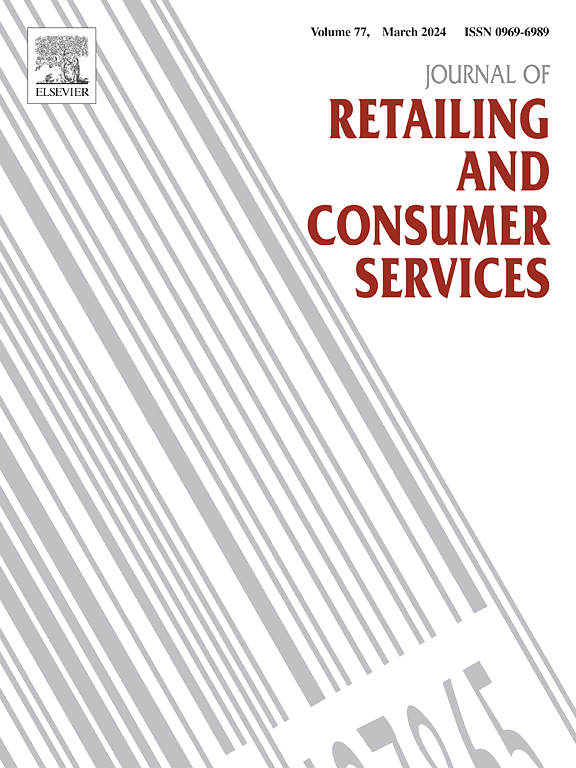考虑到消费者的失望厌恶情绪,制造商通过直播蚕食市场
IF 13.1
1区 管理学
Q1 BUSINESS
Journal of Retailing and Consumer Services
Pub Date : 2024-11-22
DOI:10.1016/j.jretconser.2024.104152
引用次数: 0
摘要
实时流媒体(LS)销售日益流行,导致许多制造商采用 LS 渠道蚕食在线市场。本文指出了 LS 渠道的三个特点:(1) 实时互动减少了产品匹配的不确定性。(2)产品匹配概率的增加减轻了消费者的失望厌恶(CDA)。 3)娱乐性和信任度的增加提高了消费者对产品的评价。考虑到供应链包括制造商和在线零售商,我们研究了制造商在集中和分散两种情况下的 LS 渠道侵占策略。我们发现,LS 渠道蚕食总是发生在集中式场景中,但不一定发生在分散式场景中。具体来说,如果 CDA 强度大,产品匹配概率小,制造商就会采取替换式蚕食。如果产品匹配概率适中,制造商就会采用竞争侵占。然而,如果产品匹配概率较大,LS 的估值提升效应较低,则制造商在集中化情景下会避免蚕食,但在分散化情景下会选择威胁性蚕食。最后,尽管 CDA 可以促进蚕食,但它总是会使制造商的利益受损。直观地说,CDA 削弱了在线零售渠道的竞争力,从而损害了零售商的利益。然而,我们的研究揭示了一个有趣的发现:当产品匹配概率足够大且LS的估值提升效应较低时,CDA会使零售商更有利。本文章由计算机程序翻译,如有差异,请以英文原文为准。
Manufacturer encroachment through live streaming considering consumer disappointment aversion
Live streaming (LS) sales are increasingly popular, leading many manufacturers to adopt the LS channel to encroach on the online market. Three characteristics of the LS channel are identified: (1) Real-time interaction reduces product matching uncertainty. (2) The increase in product matching probability mitigates consumer disappointment aversion (CDA). (3) Increased entertainment and trust enhance consumers valuation of products. Considering a supply chain that includes a manufacturer and an online retailer, we investigate the manufacturer’s LS channel encroachment strategies for both centralized and decentralized scenarios. We find that LS channel encroachment always occurs in the centralized scenario but may not necessarily take place in the decentralized scenario. Specifically, if CDA intensity is strong and product matching probability is small, the manufacturer adopts replacement encroachment. If product matching probability is moderate, the manufacturer employs competition encroachment. However, if product matching probability is large and LS’s valuation enhancement effect is low, the manufacturer avoids encroachment in the centralized scenario but chooses threatening encroachment in the decentralized scenario. Finally, although CDA can promote encroachment, it always makes the manufacturer worse off. Intuitively, CDA weakens the online retail channel’s competitiveness, thereby harming the retailer. However, our study reveals an interesting finding: When product matching probability is sufficiently large and LS’s valuation enhancement effect is low, CDA makes the retailer better off.
求助全文
通过发布文献求助,成功后即可免费获取论文全文。
去求助
来源期刊
CiteScore
20.40
自引率
14.40%
发文量
340
审稿时长
20 days
期刊介绍:
The Journal of Retailing and Consumer Services is a prominent publication that serves as a platform for international and interdisciplinary research and discussions in the constantly evolving fields of retailing and services studies. With a specific emphasis on consumer behavior and policy and managerial decisions, the journal aims to foster contributions from academics encompassing diverse disciplines. The primary areas covered by the journal are:
Retailing and the sale of goods
The provision of consumer services, including transportation, tourism, and leisure.

 求助内容:
求助内容: 应助结果提醒方式:
应助结果提醒方式:


